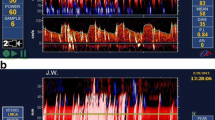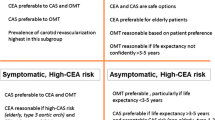Abstract
Patients with a significant carotid stenosis are at an increased risk of suffering from a potentially fatal or disabling stroke. The current management strategies available to a patient with an asymptomatic carotid stenosis are either medical therapy alone, or in combination with either carotid endarterectomy, or carotid angioplasty and stenting. Medical therapy alone can reduce the incidence of stroke in general, but whether there is any reduction in stroke attributable to a significant carotid stenosis is less clear. Carotid endarterectomy, on the other hand, has been shown to reduce the incidence of ipsilateral ischaemic stroke in both symptomatic and asymptomatic patients, with the benefits extending into the long-term. Carotid angioplasty and stenting is a newer technique with the benefit of being minimally invasive. The results of trials comparing the technique to endarterectomy have had conflicting results, and the results of large multi-centre trials are awaited. Currently the safest strategy for a patient with a significant asymptomatic carotid stenosis consists of optimal medical therapy with carotid endarterectomy for those less than 75 years of age, who are suitable for surgery.


Similar content being viewed by others
References
Amarenco P, Bogousslavsky J, Callahan A III et al (2006) Stroke prevention by aggressive reduction in cholesterol levels (sparcl) investigators. High-dose atorvastatin after stroke or transient ischemic attack. N Engl J Med 355:549–559
Antithrombitic Trialist’s Collaboration (2009) Aspirin in the primary and secondary prevention of vascular disease: collaborative meta-analysis of individual participant data from randomised trials. Lancet 373:1849–1860
Bockenheimer SA, Mathias K (1983) Percutaneous transluminal angioplasty in arteriosclerotic internal carotid stenosis. Am J Neuroradiol 4:791–792
Brott TG, Hobson RW 2nd, Howard G, Roubin GS, Clark WM, Brooks W, Mackey A, Hill MD, Leimgruber PP, Sheffet AJ, Howard VJ, Moore WS, Voeks JH, Hopkins LN, Cutlip DE, Cohen DJ, Popma JJ, Ferguson RD, Cohen SN, Blackshear JL, Silver FL, Mohr JP, Lal BK, Meschia JF, CREST Investigators (2010) Stenting versus endarterectomy for treatment of carotid-artery stenosis. N Engl J Med 363:11–23
Collins R, Peto R, MacMahon S, Herbert P, Fiebach NH, Eberlein K, Godwin J, Qizilbash N, Taylor JO, Hennekens CH (1990) Blood pressure, stroke, and coronary heart disease, II: short-term reductions in blood pressure: overview of randomised drug trials in their epidemiological context. Lancet 355:1534–1535
Collins R, Armitage J, Parish S, Sleigh P, Peto R, Heart Protection Study Collaborative Group (2003) MRC/BHF heart protection study of cholesterol-lowering with simvastatin in 5,963 people with diabetes: a randomised placebo-controlled trial. Lancet 361:2005–2016
Coward LJ, McCabe DJH, Ederle J, Featherstone RL, Clifton A, Brown MM, CAVATAS Investigators (2007) Long-term outcome after angioplasty and stenting for symptomatic vertebral artery stenosis compared with medical treatment in the carotid and vertebral artery transluminal angioplasty study (cavatas): a randomized trial. Stroke 38:1526–1530
Eckstein HH, Ringleb P, Allenberg JR, Berger J, Fraedrich G, Hacke W, Hennerici M, Stingele R, Fiehler J, Zeumer H, Jansen O (2008) Results of the stent-protected angioplasty versus carotid endarterectomy (space) study to treat symptomatic stenoses at 2 years: a multinational, prospective, randomised trial. Lancet Neurol 7:893–902
European Carotid Surgery Trialist’s Collaborative Group (1991) MCR European carotid surgery trial: interim result for symptomatic patients with severe (70–99%) or mild (0–29%) carotid stenosis. Lancet 337:1235–1243
Executive Committee for the Asymptomatic Carotid Atherosclerosis Study (1995) Endarterectomy for asymptomatic carotid stenosis. JAMA 273:1421–1428
Feasby TE, Kennedy J, Quan H, Girard L, Ghali WA (2007) Real-world replication of randomized controlled trial results for carotid endarterectomy. Arch Neurol 64:1496–1500
Hobson RW II, Weiss DG, Fields WS et al (1993) Efficacy of carotid endarterectomy for asymptomatic carotid stenosis. N Engl J Med 328:221–227
International Stroke Trial Collaborative Group (1997) The international stroke trial (IST): a randomised trial of aspirin, subcutaneous heparin, both, or neither among 19,435 patients with acute ischaemic stroke. Lancet 349:1569–1581
Marquardt L, Geraghty OC, Mehta Z, Rothwell PM (2010) Low risk of ipsilateral stroke in patients with asymptomatic carotid stenosis on best medical treatment. A prospective, population-based study. Stroke 41(1):e11–e17
Masten SL, Chang DC, Perler BA, Rosborough GS, Williams GM (2006) Trends in the in-hospital stroke rate following carotid endarterectomy in California and Maryland. J Vasc Surg 44:488–495
MRC Asymptomatic Carotid Surgery Trial (ACST) Collaborative Group (2004) Prevention of disabling and fatal strokes by successful carotid endarterectomy in patients without recent neurological symptoms: randomised controlled trial. Lancet 363:1491–1502
Naylor AR, Bolia A, Abbott RJ et al (1998) Randomized study of carotid angioplasty and stenting vs carotid endarterectomy: a stopped trial. J Vasc Surg 28:326–334
North American Symptomatic Carotid Endarterectomy Trial Collaboration (1991) Beneficial effect of carotid endarterectomy in symptomatic patients with high grade carotid stenosis. N Engl J Med 325:445–453
Yadav JS, for the SAPPHIRE Investigators (2002) Stenting and angioplasty with protection in patients at high risk for endarterectomy: the SAPPHIRE study. Circulation 106:2986–2989
Author information
Authors and Affiliations
Corresponding author
Rights and permissions
About this article
Cite this article
Hirt, L., Halliday, A. Controversies in neurology: asymptomatic carotid stenosis—intervention or just stick to medical therapy. The argument for carotid endarterectomy. J Neural Transm 118, 631–636 (2011). https://doi.org/10.1007/s00702-011-0589-6
Received:
Accepted:
Published:
Issue Date:
DOI: https://doi.org/10.1007/s00702-011-0589-6




